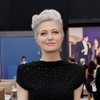GARAGE is a print and digital universe spanning the worlds of art, fashion, design, and culture. Our launch on VICE.com is coming soon, but until then, we're publishing original stories, essays, videos, and more to give you a taste of what's to come.Watching Shayne Oliver's electrifying revival of Helmut Lang, where there were granny fetish bras, men in heels and panties, blazers with harnesses instead of buttons or lapels, and "H" pasties serving as a top, I couldn't help but think: what great bags!In an absurdly commercial touch for a designer who tugs and slaps at the ideas of "wearable" or "sellable," there was fantastic attention paid to accessories. There were giant, abstracted folders and three ring binders splayed open and slung over the shoulder. Those seemed ironically impractical for something inspired by office supplies, but there were also Plexiglas briefcases—if only the business world were so enthusiastic about being transparent!—and a big belly of soft leather worn slung around the neck, which doubled in some looks as a muff. There was a little leather bag and a harness-inspired backpack that played on Oliver's bizarre-brassiere, and best of all, a rolled up HELMUT LANG newspaper tote, which a few models used to shield their eyes from the unnatural spotlight of the runway.Oliver is the designer-in-residence at the revamped cult-favorite brand, brought in under new editor-in-residence (and Dazed Editor-in-Chief) Isabella Burley. Rather than installing one designer at the helm, Burley will rotate a cast of designers to create capsule collection. On the one hand, this is a fantastic strategy for legacy houses, where those who succeed the namesake designer are sometimes stultified as they attempt to "carry on the codes of the house"—frankly, a better mandate for Paris is Burning than a luxury fashion brand trying to push new ideas or cater to modern women's tastes. But Oliver's collection was such a hot jolt that you'd love to see those ideas built upon in further collections. (Maybe Lang should take on his defunct-ish line Hood By Air as a diffusion line?) Regardless, consumers seem more open to avant-garde design of late, so those prehistoric bra clutches might create a commercially viable it-bag moment for Helmut Lang.Though far less established than Oliver, Vaquera is another brand with designers who are winning with weird. Their wild and wacky show on Tuesday, held in a boxing gym downtown with all the olfactory vigor that entails, ended with a funhouse mirror of the traditional couture finale: a bridal gown done as a bathrobe. Vaquera, a collective of four designers in their mid-twenties, have a refreshing outsider point-of-view that's less, "Nobody gets me" and more, "Nobody was getting it, so we had to do it." They aren't afraid to make you laugh—in addition to the bathrobe-ball gown, there was a slinky dress made of Vaquera-branded credit cards and a comically large bow dress ("I'm your present this year!"). But things like a puckered sweatsuit in slinky jersey and a muted gray curtain of a dress with an outrageous waterfall hem are the kind of things your average Opening Ceremony customer would look really cute in.Writing about Calvin Klein last week, Cathy Horyn rightly pointed out that many young designers aren't engaging with today's social and political chaos. While it's true that none are making social commentary at the level of Raf Simons, who is building an ambitious code of symbolism and provocation at a mass level, designers like Oliver and the slightly younger ones behind Vaquera belong to a generation that is more engaged with social and political issues than any before (hence the emphasis on diverse runway casting and gender neutral clothing). Sometimes weird clothing can just look dumb, especially to people outside the fashion industry, but this emerging era of designers has an unpretentious approach, demonstrating how clothing functions as both a mask and place of revelation for personal identity. It suggests that the runway is increasingly a place to raise questions much larger than, "But who's going to wear that?"
Photography courtesy of Dan and Corina Lecca.
